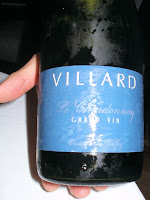Chef Acurio originally studied as a lawyer in Peru and Spain but switched to culinary studies. Anyone who recognizes that the world needs fewer lawyers and more chefs has my admiration! He’s in the same mould as Ramsey or Ducasse: he’s involved in some 26 restaurants, has his own television show, and is the author of several cookbooks. All at the age of 43. Chef Acurio is also a strong promoter of the distinctiveness of Peruvian cuisine and the pride that Peruvians should take in that distinctiveness.
The centre of Gaston Acurio’s universe is his flagship restaurant in Miraflores; it’s named “Astrid y Gaston” after Acurio and his wife (and pastry chef), Astrid Gutsche. And it’s just a short walk from our hotel.
It’s a beautiful restaurant with several dining rooms. My lucky night, our table is in the dining room that’s also the wine cellar, with racks and racks of bottles all around us. On the walls are signs with a big white S on a green background that say, “Zona Segura en Casos de Sismos” It doesn’t take a genius to figure out that’s where you stand if an earthquake hits. Just one question: how many bottles can I grab on my way to the S spot?
We arrive early again (8 pm, early by Peruvian custom) so it’s not too busy. And it’s a Monday night, so maybe it will be slow. But no, by 9:30 the place is packed and stays that way by the time we leave at 11:30. Some tourists are there, sure, but Peruvians do like good food!
We kick off with a glass of Anakena Sauvignon Blanc, from the Chilean Central Valley. Guaranteed to get the tastebuds in gear.
The menu is available in English but it’s still like being on another planet. So many choices and I have no idea what many of them are. The ingredients and cooking techniques are so specific to Peru; the menu even comes with its own dictionary to explain them all! Just dive in!
I start with Tres Cebiches, Tres Leches de Tigre. Cebiche (or ceviche) is fresh raw seafood marinated in citrus juices and seasoned with chili peppers and onion. (They don’t kid around with the chili peppers!) The presentation is 3 seafoods in 3 different dishes: octopus; a combination of smelt, squid and clams; and then sea urchin and whatever other molluscs are fresh that day. Each dish is marinated in a different mixture of citrus juices and chillies (known as leches de tigre, or tiger’s milk). Cebiche…ceviche…any way you spell it, it’s all brilliant and delicious. The seafood texture is firm yet tender, much like fresh, raw oysters, which I love as well.
Michèle opts for Conchas Power, scallops prepared 2 ways on the shell. One is cebiche-style, the other baked with citrus and tausi (fermented black beans), both accompanied with shredded seasonal vegetables.
For the main course, Michèle chose Saltado Otoñal de Lenguado y Camarones. Pacific Sole and shrimps, cooked “saltado”, which means stir-fried or sautéed over very high heat. It’s an example of the Chinese influence: literally, saltado means jumped or leaped, which is what the ingredients do in a wok. Also with scallops, mushrooms, peppers, lima beans (of course!), and two sauces: one of cream and the other that definitely has the lip-smacking Umami flavours of Chinese food.
My choice is the Mero de los Mares del Norte, Choclos y Rocoto Verde. Mero is Pacific grouper. Accompanied by a light creamy-corn sauce, sautéed corn and mushrooms, and a stuffed green chili.
For us, all the dishes are a combination of the familiar and the new. It’s all fantastic. Wonderfully fresh ingredients and perfectly prepared.
The wine? The two sommeliers (the one from the restaurant and the one at the table) discuss a few options. His advice is an oaky Chardonnay. Normally not one of my favourites but these dishes should be just rich enough to stand up to a big Chardonnay. The choice? Villard Chardonnay 2004 from Chile’s Casablanca Valley. Deep yellow-gold colour with aromas of butter and caramel right off (Malolactic fermentation and this wine has seen new oak), then pineapple, ripe peach, and nuttiness. Peach dominates on the taste, with hazelnut on the finish that yields some bitterness. Round, smooth acidity, even a bit oily. But it’s just past its prime with the fruit flavours fading on the nose and taste. Good match with the mains.
Dessert? Of course! More adventures into the unknown. I go for Cherimoya (a fruit from the Andes) with frozen orange granizado, lemon pie ice cream, and marinated oranges. Deliciously refreshing.
Michèle’s choice is Camu Camu fruit tapioca with milk chocolate mousse, frosted coconut soup, cinnamon foam, Camu Camu sorbet with orange confit. No wonder Gaston married Astrid!
After dessert comes…more dessert…a selection of mignardises. Well, if we have more to eat, we need more to drink. Hey, when in Lima, do as the Limeños do. Two glasses of Pisco please! Pisco is a distilled liquor, similar to eau de vie, made from grapes. Peru makes various levels of Pisco and we try a Pisco Puro, which is made from a single grape variety (usually Quebranta), and Pisco Aromatico, which in this case is made from the
The verdict? Gaston Acurio lives up to his stellar reputation. Fresh local ingredients, superbly prepared using both Peruvian and international techniques. Don’t miss it.
Subscribing to this blog through RSS or email is easy! Just click on the subscribe link to the left ←














No comments:
Post a Comment